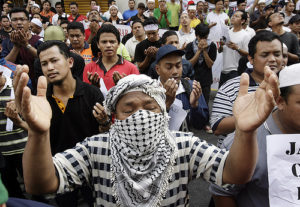
…the Southeast Asian nation boasted the world’s tallest building, the iconic 88-story Petronas Towers. Powered by electronics, palm oil and petroleum, Malaysia is the world’s 20th-largest exporter, ahead of Sweden, Australia and India. Per capita income, about $14,000 in purchasing parity terms, is about the same as in Argentina. Apart from the obvious prosperity of downtown Kuala Lumpur, the casual visitor notices the comforting trappings of a British colonial past–a parliament, a judiciary, a professional police force.
SNIP
About four in 10 Malaysians are Buddhist, Christian, Hindu , Sikh or Confucian. (By contrast, Turkey, the poster-child for an Islam at peace with the 21st century, is 99.8% Muslim.)
He then goes into the darker side of the miracle, touching on the affirmative action program that favors the Malay majority (and even ethnic Indonesians or Muslim Filipinos who migrate to Malaysia) at the expense of the Chinese and Indian minority. This system affects Malaysian citizens chances for gainful employment, housing, and college admittance.
He also speaks about how people labeled as Muslim are not legally allowed to switch religious adherence. In fact, Muslims and non-Muslims are adjudicated under different legal systems, one is a form of Sharia law, the other secular. Interfaith marriages are also illegal. The author claims that Malaysia has grown more pious since independence and he questions if the increasing religiosity of Malay majority can continue to live with the non-Muslim minority as equals. This blog has also looked at some of these questions as they relate the current political environment, which has become more racial charged in recent years.
– In an update to the conflict in Mayanmar’s Kokang region on the Chinese border, the Chinese government news agency, Xinhua, is reporting that approximately 5,800 refugees have left China in route to Kokang. 37,000 people are estimated to have fled into China’s Yunnan province from Myanmar ahead of the fighting that broke out last week. Somewhat surprisingly:
The newly-formed “Kokang Region Provisional Leading Committee” in Laukkai, led by the government, called on the out-fleeing members of the Myanmar National Democratic Alliance Army (MNDAA) to return to the legal fold, assuring them “personal safety under law”.
Although the government declared an official end to the conflict last Sunday, there have been reports of guerrilla attacks on government forces in the Kokang capital of Laogai by the MNDAA.
-The Nightly Business Report discussed the weakening Cambodian garment and tourism industries and the Cambodian governments struggle to exploit its offshore oil and gas deposits. It is believed that Cambodia has over 2 billion barrels of oil, a small find by global standards, with a lifespan of only about 10 years. Still this is a much needed cash-cow for a small developing nation. Human rights groups are not optimistic as to the affect this will have on common citizens, citing the extensive corruption to be found in the existing natural resources market, and the general lack of government oversight or regulation. Chevron is currently the most active multinational oil company in Cambodia. The government hopes to start pumping by 2012.
– Opprotunies in telecom in Vietnam:
With a low broadband penetration rate, Vietnam is poised for growth because of on-going market deregulation, sustained upgrading of the ICT infrastructure, equitization of government-owned telecom entities, 2G coverage expansion, 3G deployments and an initial rollout of WiMAX. Also, Vietnam’s recent membership in the World Trade Organization will accentuate opportunities for investors and local market players.